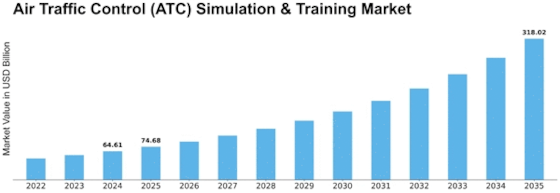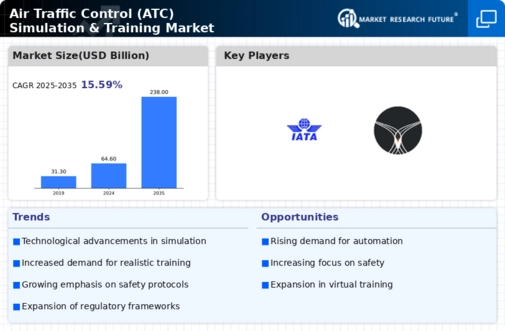-
Executive Summary
-
Market Attractiveness Analysis
- Global Air Traffic Control (ATC) Simulation & Training Market, By Training Module
- Global Air Traffic Control (ATC) Simulation & Training Market, By Component
- Global Air Traffic Control (ATC) Simulation & Training Market, By Application
- Global Air Traffic Control (ATC) Simulation & Training Market, By Region
-
Market Introduction
-
Market Definition
-
Scope Of The Study
-
Market Structure
-
Key Buying Criteria
-
Market Factor Indicator Analysis
-
Research Methodology
-
Research Process
-
Primary Research
-
Secondary Research
-
Market Size Estimation
-
Forecast Model
-
List Of Assumptions
-
Market Insights
-
Market Dynamics
-
Introduction
-
Drivers
-
Restraints
-
Opportunities
-
Challenges
-
Market/Technological Trends
-
Patent Trends
-
Regulatory Landscape/Standards
-
Market Factor Analysis
-
Value Chain/Supply Chain Analysis
- R&D
- Manufacturing
- Distribution & Sales
- Post-Sales Monitoring
-
Porter’s Five Forces Analysis
- Threat Of New Entrants
- Bargaining Power Of Buyers
- Threat Of Substitutes
- Competition
- Bargaining Power Of Supplies
-
Global Air Traffic Control (ATC) Simulation & Training Market, By Training Module
-
Introduction
-
Communication Systems
- Market Estimates & Forecast, 2019–2024
- Market Estimates & Forecast, By Region, 2019–2024
-
Navigation Systems
- Market Estimates & Forecast, 2019–2024
- Market Estimates & Forecast, By Region, 2019–2024
-
Surveillance Systems
- Market Estimates & Forecast, 2019–2024
- Market Estimates & Forecast, By Region, 2019–2024
-
Automation Systems
- Market Estimates & Forecast, 2019–2024
- Market Estimates & Forecast, By Region, 2019–2024
-
Global Air Traffic Control (ATC) Simulation & Training Market, By Component
-
Introduction
-
Hardware
- Market Estimates & Forecast, 2019–2024
- Market Estimates & Forecast, By Region, 2019–2024
-
Software
- Market Estimates & Forecast, 2019–2024
- Market Estimates & Forecast, By Region, 2019–2024
-
Global Air Traffic Control (ATC) Simulation & Training Market, By Application
-
Introduction
-
Commercial
- Market Estimates & Forecast, 2019–2024
- Market Estimates & Forecast, By Region, 2019–2024
-
Military
- Market Estimates & Forecast, 2019–2024
- Market Estimates & Forecast, By Region, 2019–2024
-
Global Air Traffic Control (ATC) Simulation & Training Market, By Region
-
Introduction
-
North America
- Market Estimates & Forecast, By Country, 2019–2024
- Market Estimates & Forecast, By Training Module, 2019–2024
- Market Estimates & Forecast, By Component, 2019–2024
- Market Estimates & Forecast, By Application, 2019–2024
- US
- Canada
-
Europe
- Market Estimates & Forecast, By Country, 2019–2024
- Market Estimates & Forecast, By Training Module, 2019–2024
- Market Estimates & Forecast, By Component, 2019–2024
- Market Estimates & Forecast, By Application, 2019–2024
- UK
- Germany
- France
- Russia
- Rest Of Europe
-
Asia-Pacific
- Market Estimates & Forecast, By Country, 2019–2024
- Market Estimates & Forecast, By Training Module, 2019–2024
- Market Estimates & Forecast, By Component, 2019–2024
- Market Estimates & Forecast, By Application, 2019–2024
- China
- Japan
- India
- Rest Of Asia-Pacific
-
Rest Of The World
- Market Estimates & Forecast, By Region, 2019–2024
- Market Estimates & Forecast, By Training Module, 2019–2024
- Market Estimates & Forecast, By Component, 2019–2024
- Market Estimates & Forecast, By Application, 2019–2024
- Middle East & Africa
- Latin America
-
Competitive Landscape
-
Competitive Overview
-
Competitor Dashboard
-
Major Growth Strategies In The Global Air Traffic Control (ATC) Simulation & Training Market
-
Competitive Benchmarking
-
Market Share Analysis
-
Key Developments & Growth Strategies
- Product Launches/Service Deployments
- Mergers & Acquisitions
- Joint Ventures
-
Company Profiles
-
International Air Transport Association (IATA)
- Company Overview
- Products/Services Offered
- Financial Overview
- Key Developments
- SWOT Analysis
- Key Strategies
-
Global ATS Ltd
- Company Overview
- Products/Services Offered
- Financial Overview
- Key Developments
- SWOT Analysis
- Key Strategies
-
NATS Limited
- Company Overview
- Products/Services Offered
- Financial Overview
- Key Developments
- SWOT Analysis
- Key Strategies
-
Advanced Simulation Technology Inc.
- Company Overview
- Products/Services Offered
- Financial Overview
- Key Developments
- SWOT Analysis
- Key Strategies
-
Tern Systems
- Company Overview
- Products/Services Offered
- Financial Overview
- Key Developments
- SWOT Analysis
- Key Strategies
-
Adacel Technologies Limited
- Company Overview
- Products/Services Offered
- Financial Overview
- Key Developments
- SWOT Analysis
- Key Strategies
-
Edda Systems AS
- Company Overview
- Products/Services Offered
- Financial Overview
- Key Developments
- SWOT Analysis
- Key Strategies
-
Saab AB
- Company Overview
- Products/Services Offered
- Financial Overview
- Key Developments
- SWOT Analysis
- Key Strategies
-
EIZO Corporation
- Company Overview
- Products/Services Offered
- Financial Overview
- Key Developments
- SWOT Analysis
- Key Strategies
-
UFA
- Company Overview
- Products/Services Offered
- Financial Overview
- Key Developments
- SWOT Analysis
- Key Strategies
-
Other Appendix
-
References
-
Related Reports
-
List Of Abbreviations
-
Industry Insights
-
Note: This Table Of Contents Is Tentative And Subject To Change As The Research Progresses.
-
-
List Of Tables
-
Global Air Traffic Control (ATC) Simulation & Training Market, By Training Module, 2019–2024
-
Global Air Traffic Control (ATC) Simulation & Training Market, By Component, 2019–2024
-
Global Air Traffic Control (ATC) Simulation & Training Market, By Application, 2019–2024
-
Global Air Traffic Control (ATC) Simulation & Training Market, By Region, 2019–2024
-
North America: Air Traffic Control (ATC) Simulation & Training Market, By Country, 2019–2024
-
North America: Air Traffic Control (ATC) Simulation & Training Market, By Training Module, 2019–2024
-
North America: Air Traffic Control (ATC) Simulation & Training Market, By Component, 2019–2024
-
North America: Air Traffic Control (ATC) Simulation & Training Market, By Application, 2019–2024
-
US: Air Traffic Control (ATC) Simulation & Training Market, By Training Module, 2019–2024
-
US: Air Traffic Control (ATC) Simulation & Training Market, By Component, 2019–2024
-
US: Air Traffic Control (ATC) Simulation & Training Market, By Application, 2019–2024
-
Canada: Air Traffic Control (ATC) Simulation & Training Market, By Training Module, 2019–2024
-
Canada: Air Traffic Control (ATC) Simulation & Training Market, By Component, 2019–2024
-
Canada: Air Traffic Control (ATC) Simulation & Training Market, By Application, 2019–2024
-
Europe: Air Traffic Control (ATC) Simulation & Training Market, By Country, 2019–2024
-
Europe: Air Traffic Control (ATC) Simulation & Training Market, By Training Module, 2019–2024
-
Europe: Air Traffic Control (ATC) Simulation & Training Market, By Component, 2019–2024
-
Europe: Air Traffic Control (ATC) Simulation & Training Market, By Application, 2019–2024
-
UK: Air Traffic Control (ATC) Simulation & Training Market, By Training Module, 2019–2024
-
UK: Air Traffic Control (ATC) Simulation & Training Market, By Component, 2019–2024
-
UK: Air Traffic Control (ATC) Simulation & Training Market, By Application, 2019–2024
-
Germany: Air Traffic Control (ATC) Simulation & Training Market, By Training Module, 2019–2024
-
Germany: Air Traffic Control (ATC) Simulation & Training Market, By Component, 2019–2024
-
Germany: Air Traffic Control (ATC) Simulation & Training Market, By Application, 2019–2024
-
France: Air Traffic Control (ATC) Simulation & Training Market, By Training Module, 2019–2024
-
France: Air Traffic Control (ATC) Simulation & Training Market, By Component, 2019–2024
-
France: Air Traffic Control (ATC) Simulation & Training Market, By Application, 2019–2024
-
Russia: Air Traffic Control (ATC) Simulation & Training Market, By Training Module, 2019–2024
-
Russia: Air Traffic Control (ATC) Simulation & Training Market, By Component, 2019–2024
-
Russia: Air Traffic Control (ATC) Simulation & Training Market, By Application, 2019–2024
-
Rest Of Europe: Air Traffic Control (ATC) Simulation & Training Market, By Training Module, 2019–2024
-
Rest Of Europe: Air Traffic Control (ATC) Simulation & Training Market, By Component, 2019–2024
-
Rest Of Europe: Air Traffic Control (ATC) Simulation & Training Market, By Application, 2019–2024
-
Asia-Pacific: Air Traffic Control (ATC) Simulation & Training Market, By Country, 2019–2024
-
Asia-Pacific: Air Traffic Control (ATC) Simulation & Training Market, By Training Module, 2019–2024
-
Asia-Pacific: Air Traffic Control (ATC) Simulation & Training Market, By Component, 2019–2024
-
Asia-Pacific: Air Traffic Control (ATC) Simulation & Training Market, By Application, 2019–2024
-
China: Air Traffic Control (ATC) Simulation & Training Market, By Training Module, 2019–2024
-
China: Air Traffic Control (ATC) Simulation & Training Market, By Component, 2019–2024
-
China: Air Traffic Control (ATC) Simulation & Training Market, By Application, 2019–2024
-
Japan: Air Traffic Control (ATC) Simulation & Training Market, By Training Module, 2019–2024
-
Japan: Air Traffic Control (ATC) Simulation & Training Market, By Component, 2019–2024
-
Japan: Air Traffic Control (ATC) Simulation & Training Market, By Application, 2019–2024
-
India: Air Traffic Control (ATC) Simulation & Training Market, By Training Module, 2019–2024
-
India: Air Traffic Control (ATC) Simulation & Training Market, By Component, 2019–2024
-
India: Air Traffic Control (ATC) Simulation & Training Market, By Application, 2019–2024
-
Rest Of Asia-Pacific: Air Traffic Control (ATC) Simulation & Training Market, By Training Module, 2019–2024
-
Rest Of Asia-Pacific: Air Traffic Control (ATC) Simulation & Training Market, By Component, 2019–2024
-
Rest Of Asia-Pacific: Air Traffic Control (ATC) Simulation & Training Market, By Application, 2019–2024
-
Rest Of The World: Air Traffic Control (ATC) Simulation & Training Market, By Region, 2019–2024
-
Rest Of The World: Air Traffic Control (ATC) Simulation & Training Market, By Training Module, 2019–2024
-
Rest Of The World: Air Traffic Control (ATC) Simulation & Training Market, By Component, 2019–2024
-
Rest Of The World: Air Traffic Control (ATC) Simulation & Training Market, By Application, 2019–2024
-
Middle East & Africa: Air Traffic Control (ATC) Simulation & Training Market, By Training Module, 2019–2024
-
Middle East & Africa: Air Traffic Control (ATC) Simulation & Training Market, By Component, 2019–2024
-
Middle East & Africa: Air Traffic Control (ATC) Simulation & Training Market, By Application, 2019–2024
-
Latin America: Air Traffic Control (ATC) Simulation & Training Market, By Training Module, 2019–2024
-
Latin America: Air Traffic Control (ATC) Simulation & Training Market, By Component, 2019–2024
-
Latin America: Air Traffic Control (ATC) Simulation & Training Market, By Application, 2019–2024
-
List Of Figures
-
Research Process Of MRFR
-
Top-Down & Bottom-Up Approaches
-
Market Dynamics
-
Impact Analysis: Market Drivers
-
Impact Analysis: Market Restraints
-
Porter''s Five Forces Analysis
-
Value Chain Analysis
-
Global Air Traffic Control (ATC) Simulation & Training Market Share, By Training Module, 2018 (%)
-
Global Air Traffic Control (ATC) Simulation & Training Market, By Training Module, 2019–2024 (USD Million)
-
Global Air Traffic Control (ATC) Simulation & Training Market Share, By Component, 2018 (%)
-
Global Air Traffic Control (ATC) Simulation & Training Market, By Component, 2019–2024 (USD Million)
-
Global Air Traffic Control (ATC) Simulation & Training Market Share, By Application, 2018 (%)
-
Global Air Traffic Control (ATC) Simulation & Training Market, By Application, 2019–2024 (USD Million)
-
Global Air Traffic Control (ATC) Simulation & Training Market Share (%), By Region, 2018
-
Global Air Traffic Control (ATC) Simulation & Training Market, By Region, 2019–2024 (USD Million)
-
North America: Air Traffic Control (ATC) Simulation & Training Market Share (%), 2018
-
North America: Air Traffic Control (ATC) Simulation & Training Market, By Country, 2019–2024 (USD Million)
-
Europe: Air Traffic Control (ATC) Simulation & Training Market Share (%), 2018
-
Europe: Air Traffic Control (ATC) Simulation & Training Market, By Country, 2019–2024 (USD Million)
-
Asia-Pacific: Air Traffic Control (ATC) Simulation & Training Market Share (%), 2018
-
Asia-Pacific: Air Traffic Control (ATC) Simulation & Training Market, By Country, 2019–2024 (USD Million)
-
Rest Of The World: Air Traffic Control (ATC) Simulation & Training Market Share (%), 2018
-
Rest Of The World: Air Traffic Control (ATC) Simulation & Training Market, By Country, 2019–2024 (USD Million)


















Leave a Comment